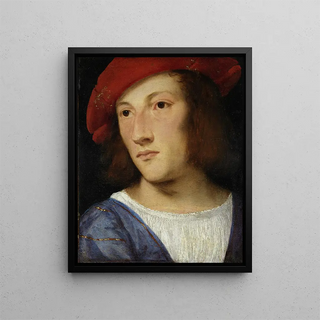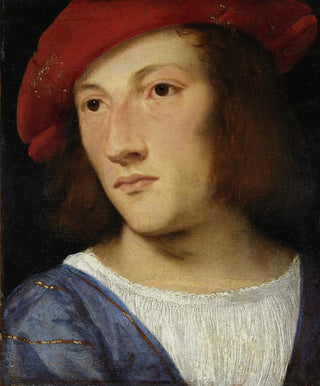Art print | Portrait of a Young Man - Titian


View from behind

Frame (optional)
Portrait of a Young Man - Titian – Captivating Introduction
The "Portrait of a Young Man" by Titian is a work that transcends time and space, a true testament to the virtuosity of the Venetian artist. Created during the Renaissance, this painting embodies not only the technical excellence of the painter but also the spirit of an era where the individual and their identity took center stage in art. Every brushstroke seems to vibrate with its own life, capturing not only the physical appearance of the subject but also a deeper essence, a psychology that invites the viewer to prolonged contemplation. This portrait, both intimate and universal, is an invitation to explore the nuances of the human soul through Titian's gaze.
Style and uniqueness of the work
Titian's style is distinguished by his mastery of colors and textures, which give his works unparalleled depth. In the "Portrait of a Young Man," the rich tones of the flesh contrast with the dark and luminous drapery, creating a captivating visual dynamic. The light, omnipresent, seems to caress the young man's face, revealing the subtleties of his expression. This play of light and shadow is characteristic of the Venetian style, where each element is carefully orchestrated to evoke emotion in the viewer. The model's posture, both relaxed and confident, reflects a self-assurance that resonates with the humanist spirit of the Renaissance. The work also stands out for its attention to detail, from the reflections in the eyes to the textures of the fabrics, demonstrating exceptional craftsmanship and a deep commitment to the art of portraiture.
The artist and his influence
Titian, whose real name is Tiziano Vecellio, is one of the pillars of Italian Renaissance painting. His influence extends far beyond his era, shaping the evolution of the portrait as an artistic genre. By integrating psychological and emotional elements into his works, he paved the way for a new way of representing the individual, which would be adopted by generations of artists. Titian was able to capture the very essence of his subjects, making them accessible and human, revolutionizing the perception of portraiture.

Matte finish

View from behind

Frame (optional)
Portrait of a Young Man - Titian – Captivating Introduction
The "Portrait of a Young Man" by Titian is a work that transcends time and space, a true testament to the virtuosity of the Venetian artist. Created during the Renaissance, this painting embodies not only the technical excellence of the painter but also the spirit of an era where the individual and their identity took center stage in art. Every brushstroke seems to vibrate with its own life, capturing not only the physical appearance of the subject but also a deeper essence, a psychology that invites the viewer to prolonged contemplation. This portrait, both intimate and universal, is an invitation to explore the nuances of the human soul through Titian's gaze.
Style and uniqueness of the work
Titian's style is distinguished by his mastery of colors and textures, which give his works unparalleled depth. In the "Portrait of a Young Man," the rich tones of the flesh contrast with the dark and luminous drapery, creating a captivating visual dynamic. The light, omnipresent, seems to caress the young man's face, revealing the subtleties of his expression. This play of light and shadow is characteristic of the Venetian style, where each element is carefully orchestrated to evoke emotion in the viewer. The model's posture, both relaxed and confident, reflects a self-assurance that resonates with the humanist spirit of the Renaissance. The work also stands out for its attention to detail, from the reflections in the eyes to the textures of the fabrics, demonstrating exceptional craftsmanship and a deep commitment to the art of portraiture.
The artist and his influence
Titian, whose real name is Tiziano Vecellio, is one of the pillars of Italian Renaissance painting. His influence extends far beyond his era, shaping the evolution of the portrait as an artistic genre. By integrating psychological and emotional elements into his works, he paved the way for a new way of representing the individual, which would be adopted by generations of artists. Titian was able to capture the very essence of his subjects, making them accessible and human, revolutionizing the perception of portraiture.






